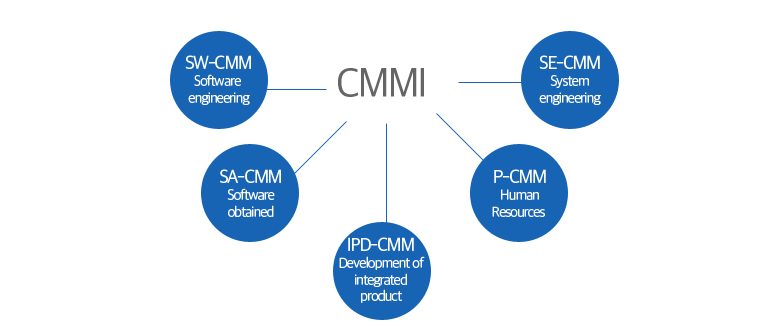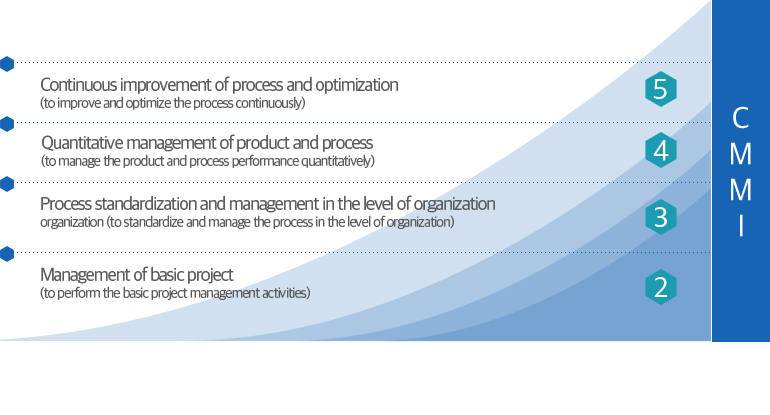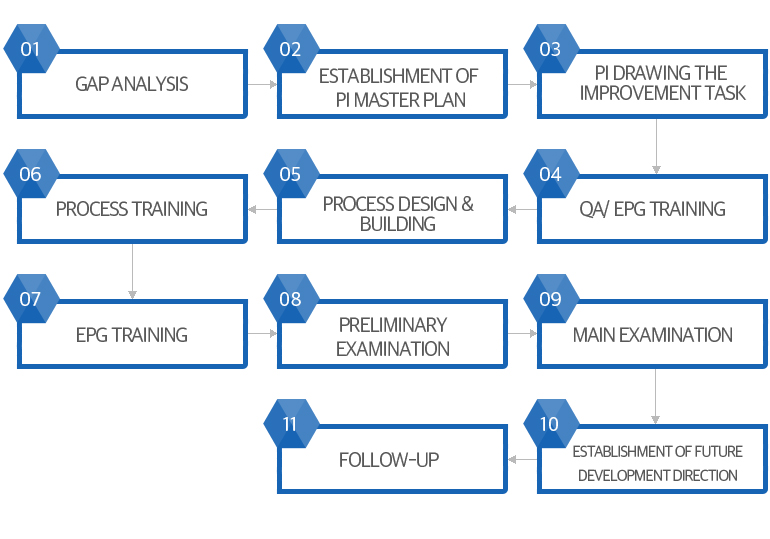#611 610 World Meridian Venture Center Primary, 254, Beotkkot-ro, Geumcheon-gu, Seoul, Korea
Tel: +82-2-2113-8268
Fax: +82-2-2113-8269
Email: bizpeer@bizpeer.co.kr
Yeongnam branch
32, Bieum-ro 4beon-gil, Seongsan-gu, Changwon-si, Gyeongsangnam-do, Korea
Tel : +82-55-252-3560
Fax : +82-55-252-3561
copyright 2015 BIZPEER.
all rights reserved.
design by itlife.

CMMI-DEV


CMMI?
CMMI is the abbreviation of Capability Maturity Model Integration for Development and a model to evaluate the process maturity of software organization and improve the performance capability by step.
This was established by CMU-SEI (Carnegie Mellon University – Software Engineering Institute) of USA in 1987 in order to prevent the insufficiency of software which are supplied to the Department of Defense basically, and has been developed as an international model by using it as the capability evaluation scale for the enterprises who supplied to the Department of Defense of USA.
Now this is applied as qualification standard for the bidders by NIST (National Institute of Standard of USA).
In addition, this divides the maturity level of software process into 1~5 steps and defines the improvement direction by step and suggests the direction so that the software organization can improve the core process gradually.
In addition, this divides the maturity level of software process into 1~5 steps and defines the improvement direction by step and suggests the direction so that the software organization can improve the core process gradually.

CMMI is an integrated model of 5 sections that existed independently in the existing CMM model, and provides the wide applicability for the process improvement activities of enterprise by integrating the system, software acquirement, human resource, development of integrated product as one process improvement frame.
On Jan. 2011, V1.3 was announced by complementing some problems in the application of model and now several models in the section of IT system operation and maintenance, the section of purchase/acquirement as well as the development section of CMMI-DEV, CMMI-SVC, CMMI-ACQ are arranged and evolved.

What will be improved if CMMI is introduced?
CMMI starts from the idea that ‘if a process is improved, the quality of product made through the process will be better’ and if the process is improved by reference of best practice suggested by CMMI , the process will become efficient and the industrial structure will be strong which results in making the effect of improvement activity doubled.

Expectation Effect of CMMI
As the quality can be measured in quantity, it is possible to predict and the re-engineering of process is available.
| Type | Immature process organization | Mature process organization |
|---|---|---|
| Process | Instable and repeated trials & errors extemporaneous approach & focusing on solving the occurred problem only |
Execute according to the planned process based on the process of organization |
| Software quality |
Unpredictable
|
Predictable
|
CMMI-ACQ 22 areas
| Type | Process Management | Project Management | Engineering | Support |
|---|---|---|---|---|
| ML5 | Organizational Performance Management | Causal Analysis & Resolution | ||
| ML4 | Organizational Process Performance | Quantitative Project Management | ||
| ML3 | Organizational Process Focus Organizational Process Definition Organizational Training |
Integrated Project Management Risk Management | Requirement Development Technical Solution Product Integration Verification Validation | Decision Analysis & Resolution |
| ML2 | Project Planning Project Monitoring & Control Supplier Agreement Management Requirements Management | Configuration Management Process & Product Quality Assurance Measurement and Analysis |
CMMI-DEV vs. SVC

Why BIZPEER?
One of largest CMMI consulting experiences in Korea and model-based PI consulting pioneer
- Started the CMM Level 2~3 baseline evaluation advice in 1999 (POSCO ICT)
- Started a CMMI based PI consulting in 2002 (Hanjin Information Communication)
- As of 2015, the CMM/CMMI based PI consulting records exceeded more than 100.
Provision of optimal PI program and continuous maintenance
- Permanent customers who receive the continuous advisory service (POSCO ICT, KOSCOM, Hyundai IT, LIG Nexone, Hyundai Rodem etc.)
Very close cooperation with CMMI evaluation instit
- Global network member of European Software Institute
- Maintain the close relation with QACL, kg
A partner of MMI w hich is a CMM , an institute of CMMI model establishment and distrribjtion
Experiences in various business area (SI, Defense, Finance, Publi,c, Automobile, Embeded SW)
Available to approach with general quality management consulting organization with TQM thinking
- TQM Master Planning, measurement of management performance, improvement of product quality
Consulting Methodology
BIZPEER secures its own consulting methodology based on the largest consulting experiences in the CMMI section which enables to build the process suitable for the requirements of customer fast ad ore correct







